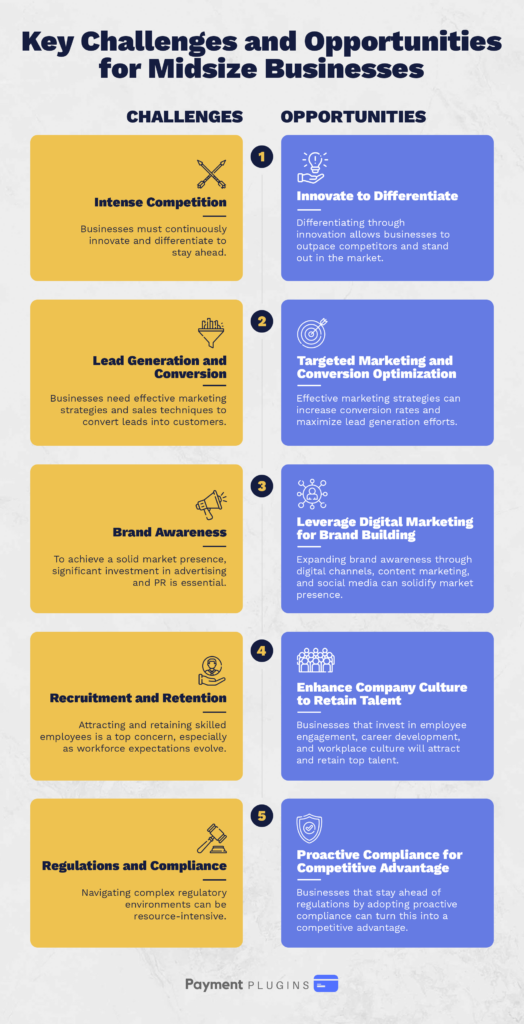
In 2025, growing and scaling your small or midsize business is crucial for staying competitive and capitalizing on new market opportunities.
Let’s talk about key strategies on how to scale your business, including understanding your market, prioritizing your customers, gathering and adopting feedback, attracting and retaining quality employees, and investing in technology so you can seize the opportunities that 2025 presents.
Growth vs. Scaling
Growth and scaling, while often used interchangeably, have distinct meanings in the business context.
Growth refers to increasing the size of your business by generating more revenue, hiring more employees, and expanding operations. It involves a linear increase where more resources lead to more output.
On the other hand, scaling is about enhancing your business’s efficiency and effectiveness with the resources you already have, ensuring you can handle increased demand without a proportional increase in costs. Scaling refers to optimizing processes and systems to support sustainable growth and maximize profitability, allowing your business to grow exponentially without a corresponding rise in operational expenses.
How to Grow Your Business Online
Growing your business in an online environment requires a multifaceted approach that leverages digital tools and strategies.
Online advertising, such as pay-per-click (PPC) campaigns, can raise brand awareness and drive targeted traffic to your website. Search Engine Optimization (SEO) is essential for improving your site’s visibility on search engines and making it easier for potential customers to find you organically. Social media platforms offer powerful marketing channels to engage with your audience, share content, and build a loyal community.
Tools like Semrush can assist in these efforts by providing insights into keyword performance, competitive analysis, and content optimization, which can increase site traffic and potentially boost sales.
Key Challenges and Opportunities
Midsize businesses today face a variety of challenges and opportunities, including these:
- Intense Competition: Businesses must continuously innovate and differentiate to stay ahead.
- Lead Generation and Conversion: Businesses need effective marketing strategies and sales techniques for this top concern.
- Brand Awareness: To get a good market presence, businesses will need to make significant investments in advertising and public relations.
- Recruitment and Retention: An ongoing challenge, intensified by cultural changes and shifting workforce expectations.
- Regulations and Compliance: Navigating complex regulations can be resource-intensive.
However, these challenges also present opportunities; businesses that effectively address them can achieve significant growth and sustainability.

Understand Your Market
Conducting thorough market research through surveys and studies can help you gather valuable insights into customer preferences, behaviors, and pain points. Analyzing competitors is equally important, as it allows you to identify successful strategies and potential gaps in the market.
Prioritize Your Customers
Establishing trust with customers can help you build long-term relationships and foster loyalty. When customers trust your brand, they are more likely to make repeat purchases and recommend your products or services to others.
Quality customer support plays a role in maintaining this trust, as prompt and helpful assistance can resolve issues quickly and effectively. Providing a great customer experience involves understanding and meeting customer expectations at every touchpoint, from website navigation to post-purchase interactions. Personalizing interactions, offering incentives for feedback, and implementing a seamless purchasing process are also effective strategies for retaining current clients and attracting new ones.
Gather and Adopt Feedback
Feedback provides valuable insights into customer satisfaction, preferences, and areas for improvement. By actively soliciting and listening to feedback through surveys, reviews, and direct interactions, businesses can identify pain points and opportunities to enhance their offerings. Adopting customer feedback also involves using positive feedback to reinforce what customers value most.
This iterative process of gathering and adopting feedback improves product quality and service delivery and strengthens customer relationships by demonstrating responsiveness and commitment to meeting their needs.
Attract and Retain Quality Employees

Quality employees bring valuable skills, innovation, and dedication to the workplace. They drive productivity and foster a positive company culture. They contribute to operational efficiency and customer satisfaction.
Retaining such employees ensures continuity and minimizes recruitment costs with the benefits of their experience and expertise for long-term strategic goals. A satisfied and motivated workforce enhances employer branding, attracts top talent, and reinforces the company’s reputation as a top employer.
How to Attract Top Talent
How can you attract top talent? Offer competitive salaries, comprehensive benefits, and opportunities for career advancement. Additionally, foster a dynamic and inclusive work environment that emphasizes work-life balance and employee well-being.
Attract candidates who align with your organizational goals and values by promoting your company’s values and mission through effective branding. Social media, professional networks, and employee referrals can also broaden your reach and attract high-caliber professionals who are a good fit for your team.
How to Retain Employees
The cost of employee turnover can be staggering, often ranging from 100% to 150% of an employee’s annual salary when accounting for recruitment, training, and lost productivity.
To retain quality employees, offer comprehensive incentives such as competitive salaries, robust benefits packages, and performance bonuses. Emphasize work-life balance through flexible schedules, remote work options, and wellness programs.
Additionally, providing clear pathways for career advancement, professional development opportunities, and attractive retirement plans can foster long-term loyalty and commitment among employees.
Strategically Outsource
Strategically outsourcing involves delegating specific business functions or tasks to external vendors or specialists, which allows companies to focus on core activities and take advantage of external expertise. This approach can help businesses grow and scale by reducing operational costs, enhancing efficiency, and accessing specialized skills that may not be available in-house.
By outsourcing non-core activities, companies can allocate more resources to innovation, customer service, and strategic planning, ultimately driving growth and competitive advantage.
Develop Seasoned Employees
Developing seasoned employees is essential for business growth and scalability. This process involves instructor-led training, hands-on experience, and simulations to build practical skills. Regular meetings and workshops can facilitate knowledge sharing and team collaboration. Providing continuous feedback and mentoring helps employees refine their skills and understand areas for improvement.
Invest in Technology to Scale Your Business

According to a report by the U.S. Chamber of Commerce, 95% of small businesses use at least one technology platform, and 87% say these platforms have improved their operational efficiency. The impact of technology investments on business performance is substantial.
A significant example is Payment Plugins, which integrates with your e-commerce platform to securely process various payment methods, manage subscriptions, and handle invoicing. They reduce manual processing errors, speed up transactions, and provide valuable data analytics for better financial planning.
Don’t Scale Too Fast
Growing or scaling too fast can lead to compromises that erode customer trust and potentially result in business failure. To avoid these pitfalls, maintain a balance between growth and quality. Ensure that your infrastructure, including customer service and product quality, can handle the increased demand. Prioritize maintaining strong relationships with existing customers by keeping your original promises and not compromising on core values. Financial prudence is also essential—invest based on actual revenue rather than projections to avoid unsustainable spending that could jeopardize your business’s stability.
Analyze and Plan Ahead
To analyze whether your business has the capacity to grow and scale, begin by evaluating your current resources, systems, and team capabilities. Identify the key challenges your business currently faces, such as bottlenecks in production, limited staff, or outdated technology. Consider the potential impacts of growth, including increased demand and the need for improved infrastructure.
Businesses with a written plan have a 30% higher chance of growth and twice the likelihood of success. To double or triple your sales, you may need to invest in technology, hire additional staff, and streamline operations. Improving policies and procedures, such as implementing automated systems for efficiency and enhancing customer service protocols, will also support sustainable growth.
Budget/Have Funds in Reserve
Can your business afford to expand? Evaluate your current financial health and future revenue projections. If funds are insufficient, consider strategies to increase capital, such as securing loans, attracting investors, or improving cash flow. Ensure you have adequate funds to manage sustained growth, including unexpected expenses. Maintaining a reserve fund is crucial in case growth initiatives do not succeed.
Continue to Improve and Adapt

Stay ahead by regularly evaluating your processes, embracing new technologies, and responding to market changes. For online businesses, using Payment Plugins can significantly aid growth and scalability. These tools can scale with your business, simplify transactions, and improve customer experience. They can streamline your payment processes, reduce manual effort, and support your expansion efforts.
Try Payment Plugins today to boost your business’s growth and efficiency.
